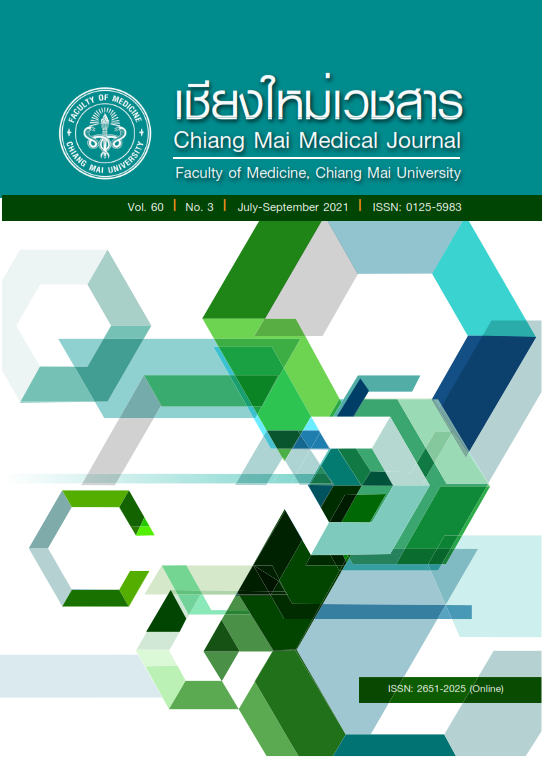Performance of deep learning in differentiating between distal ureteric calculi and non-calculous calcifications on a KUB radiographs
Keywords:
Distal ureteric stone, Non-calculous calcification, Phlebolith, Deep learning, transfer learning, pretrained network.Abstract
Objectives The objective of this study was to evaluate the performance of deep learning (DL) in the differentiation of distal ureteric calculi and non-calculous calcification on kidney, ureter and bladder (KUB) radiographs.
Methods A retrospective review of KUB radiographs of 204 patients with 235 distal ureteric stones and 138 patients with 235 non-calculous calcifications that had been previously identified by investigation, including CT, IVP or URSL, performed at the Department of Radiology, Faculty of Medicine, Chiang Mai University from September 2013 to September 2019. Every calcified density was selected and was cropped into small images. A total of 185 images from each group were randomly selected to be a training dataset and were applied to three pretrained DL networks (AlexNet, GoogLeNet and ResNet50). The remaining 50 images in each group were reserved to be a blind testing dataset. STATA version 14.2 software was used to analyze the sensitivity, specificity, positive predictive value (PPV), negative predictive value (NPV) and accuracy of each network. Logistic regression was used to calculate the Area Under the Curve (AUC) and the Chi-squared test was used to compare the AUC between the three networks.
Results The sensitivity of the three DL networks was more than 80%, specificity more than 65%, PPV more than 70%, NPV more than 80% and accuracy about 80%. The AUC (95% CI) of the AlexNet network in differentiation of ureteric calculi and non-calculous calcification was 0.79 (0.71-0.87) compared with 0.81 (0.74-0.88) for GoogLeNet and 0.82 (0.74-0.90) for ResNet50 (p = 0.43).
Conclusions DL provides good results in the differentiation of distal ureteric calculi and non-calculous calcification from KUB radiographs.
References
Liu YC, Liao B, Luo D, Wang K, Li H, Zeng G. Epidemiology of urolithiasis in Asia. Asian Journal of Urology. 2018;5:205-14.
Cheng PM, Moin P, Dunn MD, Boswell WD, Duddalwar VA. What the radiologist needs to know about urolithiasis: part 1--pathogenesis, types, assessment, and variant anatomy. AJR Am J Roentgenol. 2012;198: W540-7.
Kambadakone AR, Eisner BH, Catalano OA, Sahani DV. New and Evolving Concepts in the Imaging and Management of Urolithiasis: Urologists’ Perspective. Radio Graphics. 2010;30:603-23.
Brisbane W, Bailey MR, Sorensen MD. An overview of kidney stone imaging techniques. Nat Rev Urol. 2016; 13:654-62.
Coursey CA, Casalino DD, Remer EM, Arellano RS, Bishoff JT, Dighe M, et al. ACR Appropriateness Criteria (R) acute onset flank pain--suspicion of stone disease. Ultrasound Q. 2012;28:227-33.
Fulgham PF, Assimos DG, Pearle MS, Preminger GM. Clinical effectiveness protocols for imaging in the management of ureteral calculous disease: AUA technology assessment. J Urol. 2013;189:1203-13.
Srisubat A, Cheapudee S, Thaiyakul A. Study of numbers, distribution and characteristics of high technology radiodiagnostic imaging in Thailand unknown: unknown; [updated 2018 Feb 2; cited 2020 Jan 26]. Available from: http://medicaldevices.oie.go.th/article.aspx?aid=8236. [in Thai]
The Medical Council of Thailand. Physicians Statistics: [updated 2020 Jan 8; cited 2020 Jan 26]. Available from: https://tmc.or.th/statistics.php [in Thai]
Thai Programmer. What is Artificial Intelligence (AI): (Nessessence, Editor, Thai Programmer) [updated 2018 Dec 15; [cited 2020 Jan 25]. Available from: https://www. thaiprogrammer. org/2018/12/whatisai/. [in Thai]
Suzuki K. Overview of deep learning in medical imaging. Radiol Phys Technol. 2017;10:257-73.
McBee MP, Awan OA, Colucci AT, Ghobadi CW, Kadom N, Kansagra AP, et al. Deep Learning in Radiology. Acad Radiol. 2018;25:1472-80.
Introducing Deep Learning with MATLAB [cited 2020 Jan 11]. Available from: https://www.mathworks.com/campaigns/offers/deep-learning-with-matlab.html?elqCampaignId=10588.
Saba L, Biswas M, Kuppili V, Cuadrado Godia E, Suri HS, Edla DR, et al. The present and future of deep learning in radiology. Eur J Radiol. 2019;114:14-24.
Bergstra J, Breuleux O, Bastien F, Lamblin P, Pascanu R, Desjardins G, et al. Theano: A CPU and GPU math compiler in Python. In: Stefan W and Jarrod M, editors. Proc 9th. Texas: Python in Science Conf; 2010. p.3-10..
Traubici J, Neitlich JD, Smith RC. Distinguishing pelvic phleboliths from distal ureteral stones on routine unenhanced helical CT: is there a radiolucent center? AJR Am J Roentgenol. 1999;172:13-7.
Ebrahimi S, Mariano VY. Image quality improvement in kidney stone detection on computed tomography images. Journal of Image and Graphics. 2015;23:268-76.
Tan C, Sun F, Kong T, Zhang W, Yang C, Liu C. A Survey on deep transfer learning. In: Kůrková V, Manolopoulos Y, Hammer B, Iliadis L, Maglogiannis I, editors. Artificial Neural Networks and Machine Learning – ICANN 2018. Switzerland: Springer; 2018. p. 270-9.
Wang K, Gao X, Zhao Y, Li X, Dou D, Xu C, editors. Pay Attention to Features, Transfer Learn Faster CNNs. International Conference on Learning Representations; 2020.
Krizhevsky A, Sutskever I, Hinton GE. ImageNet classification with deep convolutional neural networks. Proceedings of the 25th International Conference on Neural Information Processing Systems - Volume 1; Lake Tahoe, Nevada: Curran Associates; 2012. p. 1097–105.
Szegedy C, Wei L, Yangqing J, Sermanet P, Reed S, Anguelov D, et al, editors. Going deeper with convolutions. 2015 IEEE Conference on Computer Vision and Pattern Recognition (CVPR); 2015 7-12 June 2015.
He K, Zhang X, Ren S, Sun J, editors. Deep Residual Learning for Image Recognition. 2016 IEEE Conference on Computer Vision and Pattern Recognition (CVPR); 2016 27-30 June 2016.
Lee HJ, Kim KG, Hwang SI, Kim SH, Byun SS, Lee SE, et al. Differentiation of urinary stone and vascular calcifications on non-contrast CT images: an initial experience using computer aided diagnosis. J Digit Imaging. 2010;23:268-76.











